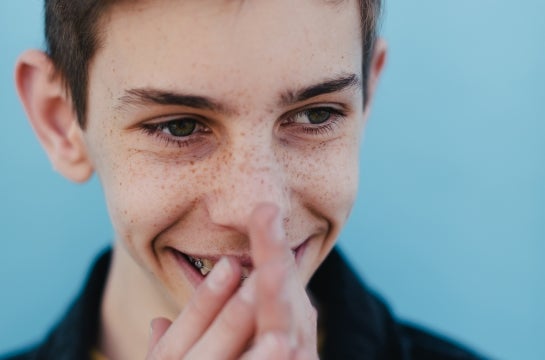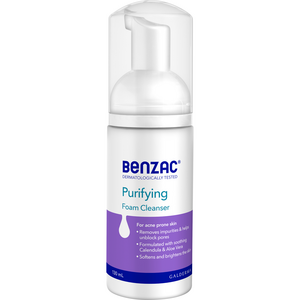What is mild to moderate acne?

Acne is a frustrating skin condition that has been found to affect approximately 93% of 16 to 18-year-olds in Australia.* But not all acne is created equal. Cases of light acne may go away on their own or be easily treatable using over-the-counter skincare products, while more severe acne will require a trip to your doctor or dermatologist.
In this article, we’re going to be discussing mild to moderate acne and what you can do about it. First step: understanding what acne can look like, the different types and how it can be treated.
What does mild acne look like?
Mild acne is likely to only cover a small part of your face, rather than spreading across the face and body. Blackheads and whiteheads are the main culprits found in mild acne, although you may also get the occasional pimple.
Whiteheads are small white bumps that appear on the surface of the skin. They are formed when a pore becomes blocked with oil, bacteria, and dead skin cells, and the pore remains closed. There may be redness around the whitehead if it worsens, but they do not usually cause you any pain.
If the clogged pore opens up, the oxygen it is exposed to darkens the whitehead, resulting in a blackhead. Like whiteheads, these won’t cause any pain and are pretty innocuous. If the clogged pore then becomes infected due to all the bacteria, it becomes a pimple. Pimples are typically redder, more swollen, and more painful than blackheads and whiteheads.
You can read more about the difference between pimples and acne in one of our previous blogs.
What does moderate acne look like?
Moderate acne breakouts tend to cover a larger portion of your face or body and usually last for longer before clearing up. It will take some patience and the right skincare products to get rid of moderate acne. You may still have whiteheads and blackheads, but you can also add papules and pustules on top of that.
Papules and pustules are considered as inflammatory acne because they typically come with redness, swelling, and some pain or discomfort. Papules are formed when a blocked pore ruptures and spreads bacteria into the surrounding skin tissue. This forms a bump under the skin’s surface that appears rough, red, and inflamed.
If a papule becomes infected and fills with pus, it is known as a pustule. This is what people typically mean when they use the word pimple. A pustule appears as red skin filled with white or yellow liquid.

How to treat mild acne
If handled badly, acne can lead to scarring, which can be lasting and something we all want to avoid. It’s important to do your research and use skin-friendly products and treatments rather than picking and scrubbing away. Here are a few things to avoid when trying to treat mild acne.
• Picking your spots
• Washing your face too often or scrubbing too hard
• Covering acne with lots of makeup
• Resting your head in your hands whilst in class or watching TV
• Avoiding sunscreen or sun protection whilst out in the sun
• Forgetting to wash or shower after exercise
All of these things can make your acne worse, or at least make it come back with a vengeance the next time you break out. Proper acne treatment is about maintaining a balanced skincare and hygiene routine and using the right products for your skin.
Skincare products for mild acne
The kind of product you choose will depend partially on your skin, i.e. if you have oily, dry, or normal skin. But there are some ingredients to look out for in the products you choose, most notably benzoyl peroxide.
Our products use benzoyl peroxide combined with other effective, skin-friendly ingredients. For an all-in-one solution, try the Benzac Clear Skin Acne Control Kit, with three different products for cleaning your skin, treating breakouts, and moisturising your skin afterwards. Acne products that dry out your skin make future breakouts more likely because your glands respond by producing more oil. So, moisturising is an important follow-up step that is often overlooked.
This ingredient is effective at killing the bacteria that can cause acne, as well as reducing the likelihood of the bacteria growing and spreading. This makes benzoyl peroxide good for not only treating acne, but also preventing it from coming back in the future. It can also stop mild acne from developing into moderate acne.
Other tips for fighting mild acne
There are certain things you can do to support the results of your topical acne products, as well as avoiding the no-nos we listed above.
• Wash your face morning and night – Developing acne doesn’t mean you’re unclean, but maintaining a regular hygiene regime does help to fight it. The trap that many teens fall into is cleaning too often. Simply wash your face when you get out of bed in the morning and before going to bed at night, and don’t scrub too hard!
• Keep bacteria away from your face – We can’t avoid bacteria altogether, but there are certain things we can do. Items that regularly touch our faces can spread a lot of bacteria to the skin, so try to keep them clean. This includes your pillowcase, phone, hair, hands, and clothing or sporting equipment such as hats and helmets.
• Moisturise – Since your glands produce more oil when your skin is dry, moisturising regularly is another important part of fighting acne. Moisturisers help to keep your skin healthy, supple and less oily. Look for lightweight moisturisers that are non-comodegenic, which means they won’t clog your pores.
Follow these tips and invest in the right products to treat your mild acne. Or if you’re researching this for your kids, then take a look at some more tips to help your teen manage acne
*Kilkenny M et al. Br J Dermatol 1998 Nov;139(5):840-5. Accessible at https://www.ncbi.nlm.nih.gov/pubmed/9892951






